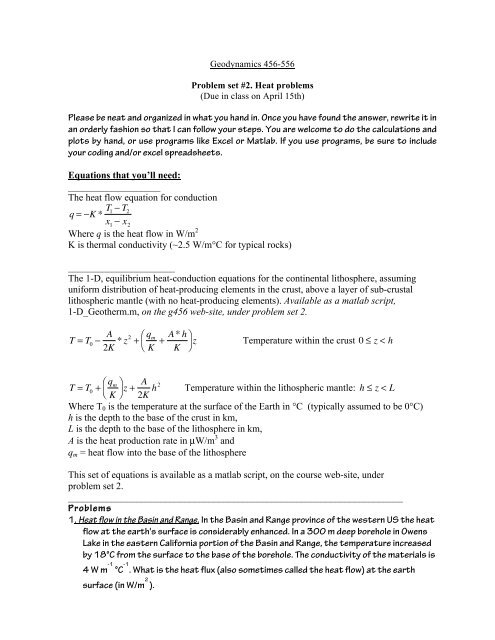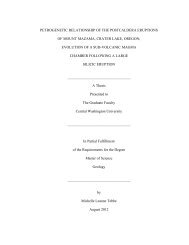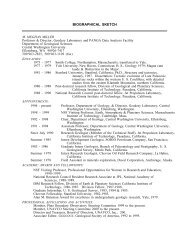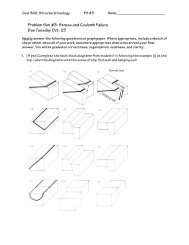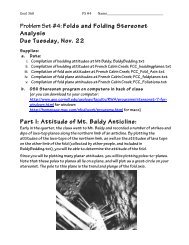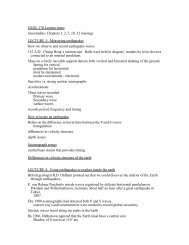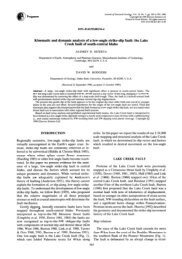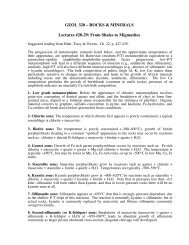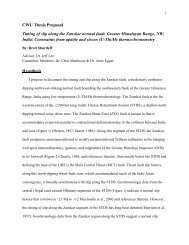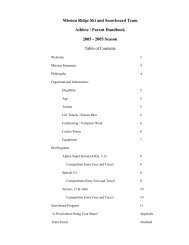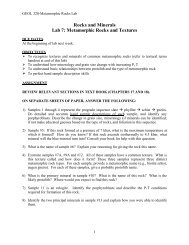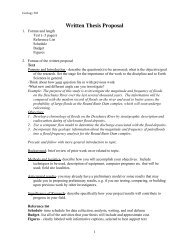Problem Set 2
Problem Set 2
Problem Set 2
You also want an ePaper? Increase the reach of your titles
YUMPU automatically turns print PDFs into web optimized ePapers that Google loves.
Geodynamics 456-556<strong>Problem</strong> set #2. Heat problems(Due in class on April 15th)Please be neat and organized in what you hand in. Once you have found the answer, rewrite it inan orderly fashion so that I can follow your steps. You are welcome to do the calculations andplots by hand, or use programs like Excel or Matlab. If you use programs, be sure to includeyour coding and/or excel spreadsheets.Equations that you’ll need:___________________The heat flow equation for conductionq = −K * T 1 − T 2x 1− x 2Where q is the heat flow in W/m 2K is thermal conductivity (~2.5 W/m°C for typical rocks)______________________The 1-D, equilibrium heat-conduction equations for the continental lithosphere, assuminguniform distribution of heat-producing elements in the crust, above a layer of sub-crustallithospheric mantle (with no heat-producing elements). Available as a matlab script,1-D_Geotherm.m, on the g456 web-site, under problem set 2.T = T 0− A2K * ⎛z2 +⎝q mK +A * hK⎞⎠ zTemperature within the crust 0 ≤ z < h⎛T = T 0+q m ⎞⎝ K ⎠ z + A2K h 2 Temperature within the lithospheric mantle: h ≤ z < LWhere T 0 is the temperature at the surface of the Earth in °C (typically assumed to be 0°C)h is the depth to the base of the crust in km,L is the depth to the base of the lithosphere in km,A is the heat production rate in µW/m 3 andq m = heat flow into the base of the lithosphereThis set of equations is available as a matlab script, on the course web-site, underproblem set 2._____________________________________________________________________<strong>Problem</strong>s1. Heat flow in the Basin and Range. In the Basin and Range province of the western US the heatflow at the earth's surface is considerably enhanced. In a 300 m deep borehole in OwensLake in the eastern California portion of the Basin and Range, the temperature increasedby 18°C from the surface to the base of the borehole. The conductivity of the materials is4 W m -1 °C -1 . What is the heat flux (also sometimes called the heat flow) at the earthsurface (in W/m 2 ).
2. Thermal profile in and beneath an ice sheet. Consider a portion of the Antarctic ice sheet thatis 2 km thick (in places it is significantly more than this). The mean annual surfacetemperature is -50°C. The surface heat flow out of the top of the ice is 54 mW m -2 , whichis a decent average for Antarctica. The conductivity of ice is 2.2 W m -1 °C -1 , and that ofthe underlying bedrock is 3.5 W m -1 °C -1 .a) Calculate and then plot the steady state geotherm for this location, taking thetemperature profile down into the underlying rock by 2 km. Assume no heatproduction takes place. Hint: since we are assuming steady-state conditions, with noheat production, then heat flow out of the top of the ice is equal to heat flow out ofthe top of the bedrock. You can use the heat flow equation for conduction to calculatethe temperature at the bottom of the ice (using K for ice). Now you know thetemperature at the top of the bedrock, and you can use the heat flow equation forconduction to determine the temperature within the bedrock (using K for bedrock).b) In many locations in Antarctica the ice is thick enough to melt at the base forming subglaciallakes (if your interested, google Lake Vostok for info on one of the largest andbest studied sub-glacial lakes). Calculate how thick the ice has to be to melt using thesame values as above.3. Contribution of radioactive heat sources to surface heat flow. Consider the case of uniformlydistributed radioactive heat sources. The surface heat flow is measured to be 54 mW m 2 ,and the measured heat production rate due to radioactive heat sources, A, is 1.25µW/m 3 . The lithosphere is 125 km thick, and the crust is 30 km thicka) Estimate the mantle heat flow in this location.b) What fraction of the surface heat flow in this location comes from the mantle, andwhat fraction comes from the decay of radioactive elements?4. Internal heat of Venus. On missions to Venus, the surface temperature was measured to be470°C, and at heat producing elements were measured as follows:Heat generation (10 -10 W/kg) ofelements at site Venera 8K 0.17U 0.60Th 0.97The measured density of the Venusian crust is 2.8 x 10 3 kg/m 3 .a) calculate the heat generation in µW/m 3 .b) Assuming a uniform distribution of the heat-producing elements through out the top50 km, use the one-dimensional equilibrium heat-conduction equation to calculate andplot the Venus geotherms (Aphroditotherms) down to 50km depth. Assume thatconductivity is 2.5 W/(m °C); that the heat flow from the mantle and deep lithopshereof Venus is 21 mW/m 2 .c) Discuss what these Aphroditotherms suggest about the internal structure of theplanet.
5. Archean geotherms: Early in the Earth’s history there was a much higher concentration ofthe heat producing isotopes of U, Th, and K. It is estimated that in the Archean (~3500 Ma)heat generation was about 3.5x what it is today. Today, a “typical” value of crustal heatproduction is 1.25 µW/m 3 . Assuming an Archean mantle heat flux of 63 mW/m 2 , and auniform distribution of heat producing elements in the crust, and an Archean crustalthickness of 20 km, determine the thickness of Archean continental lithosphere assuming thatthe temperature at the base of the lithosphere is 1100°C (the temperature where mantlebehaves elastically, and can be considered part of the plate)


